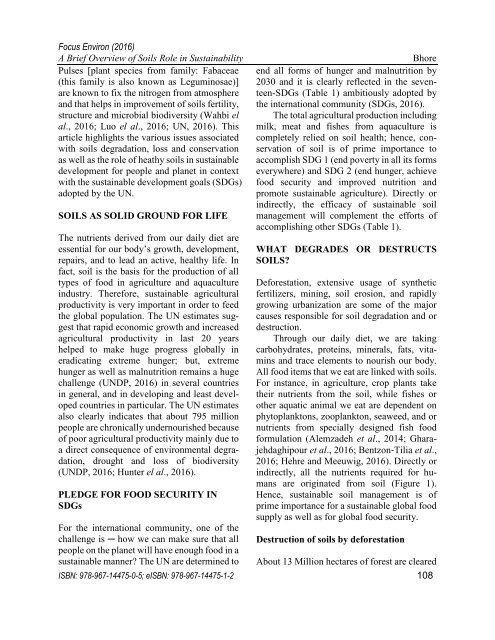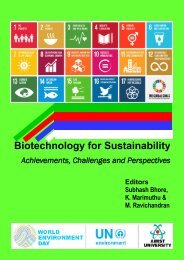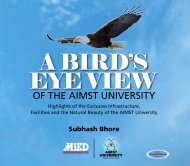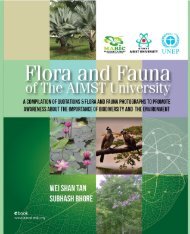Focus on Environment
This book is the Proceedings of the ‘National Seminar on Sustainable Environment and Health 2016’ & ‘World Environment Day-2016 (WED-2016)’ events held on the campus of AIMST University, Kedah, Malaysia. ISBN: 978-967-14475-0-5 (Print version); eISBN: 978-967-14475-1-2 (e-Book version) Editors Subhash Bhore & K. Marimuthu
This book is the Proceedings of the ‘National Seminar on Sustainable Environment and Health 2016’ & ‘World Environment Day-2016 (WED-2016)’ events held on the campus of AIMST University, Kedah, Malaysia.
ISBN: 978-967-14475-0-5 (Print version); eISBN: 978-967-14475-1-2 (e-Book version)
Editors
Subhash Bhore & K. Marimuthu
You also want an ePaper? Increase the reach of your titles
YUMPU automatically turns print PDFs into web optimized ePapers that Google loves.
<str<strong>on</strong>g>Focus</str<strong>on</strong>g> Envir<strong>on</strong> (2016)<br />
A Brief Overview of Soils Role in Sustainability<br />
Pulses [plant species from family: Fabaceae<br />
(this family is also known as Leguminosae)]<br />
are known to fix the nitrogen from atmosphere<br />
and that helps in improvement of soils fertility,<br />
structure and microbial biodiversity (Wahbi el<br />
al., 2016; Luo el al., 2016; UN, 2016). This<br />
article highlights the various issues associated<br />
with soils degradati<strong>on</strong>, loss and c<strong>on</strong>servati<strong>on</strong><br />
as well as the role of heathy soils in sustainable<br />
development for people and planet in c<strong>on</strong>text<br />
with the sustainable development goals (SDGs)<br />
adopted by the UN.<br />
SOILS AS SOLID GROUND FOR LIFE<br />
The nutrients derived from our daily diet are<br />
essential for our body’s growth, development,<br />
repairs, and to lead an active, healthy life. In<br />
fact, soil is the basis for the producti<strong>on</strong> of all<br />
types of food in agriculture and aquaculture<br />
industry. Therefore, sustainable agricultural<br />
productivity is very important in order to feed<br />
the global populati<strong>on</strong>. The UN estimates suggest<br />
that rapid ec<strong>on</strong>omic growth and increased<br />
agricultural productivity in last 20 years<br />
helped to make huge progress globally in<br />
eradicating extreme hunger; but, extreme<br />
hunger as well as malnutriti<strong>on</strong> remains a huge<br />
challenge (UNDP, 2016) in several countries<br />
in general, and in developing and least developed<br />
countries in particular. The UN estimates<br />
also clearly indicates that about 795 milli<strong>on</strong><br />
people are chr<strong>on</strong>ically undernourished because<br />
of poor agricultural productivity mainly due to<br />
a direct c<strong>on</strong>sequence of envir<strong>on</strong>mental degradati<strong>on</strong>,<br />
drought and loss of biodiversity<br />
(UNDP, 2016; Hunter el al., 2016).<br />
PLEDGE FOR FOOD SECURITY IN<br />
SDGs<br />
For the internati<strong>on</strong>al community, <strong>on</strong>e of the<br />
challenge is ─ how we can make sure that all<br />
people <strong>on</strong> the planet will have enough food in a<br />
sustainable manner? The UN are determined to<br />
Bhore<br />
end all forms of hunger and malnutriti<strong>on</strong> by<br />
2030 and it is clearly reflected in the seventeen-SDGs<br />
(Table 1) ambitiously adopted by<br />
the internati<strong>on</strong>al community (SDGs, 2016).<br />
The total agricultural producti<strong>on</strong> including<br />
milk, meat and fishes from aquaculture is<br />
completely relied <strong>on</strong> soil health; hence, c<strong>on</strong>servati<strong>on</strong><br />
of soil is of prime importance to<br />
accomplish SDG 1 (end poverty in all its forms<br />
everywhere) and SDG 2 (end hunger, achieve<br />
food security and improved nutriti<strong>on</strong> and<br />
promote sustainable agriculture). Directly or<br />
indirectly, the efficacy of sustainable soil<br />
management will complement the efforts of<br />
accomplishing other SDGs (Table 1).<br />
WHAT DEGRADES OR DESTRUCTS<br />
SOILS?<br />
Deforestati<strong>on</strong>, extensive usage of synthetic<br />
fertilizers, mining, soil erosi<strong>on</strong>, and rapidly<br />
growing urbanizati<strong>on</strong> are some of the major<br />
causes resp<strong>on</strong>sible for soil degradati<strong>on</strong> and or<br />
destructi<strong>on</strong>.<br />
Through our daily diet, we are taking<br />
carbohydrates, proteins, minerals, fats, vitamins<br />
and trace elements to nourish our body.<br />
All food items that we eat are linked with soils.<br />
For instance, in agriculture, crop plants take<br />
their nutrients from the soil, while fishes or<br />
other aquatic animal we eat are dependent <strong>on</strong><br />
phytoplankt<strong>on</strong>s, zooplankt<strong>on</strong>, seaweed, and or<br />
nutrients from specially designed fish food<br />
formulati<strong>on</strong> (Alemzadeh et al., 2014; Gharajehdaghipour<br />
et al., 2016; Bentz<strong>on</strong>‐Tilia et al.,<br />
2016; Hehre and Meeuwig, 2016). Directly or<br />
indirectly, all the nutrients required for humans<br />
are originated from soil (Figure 1).<br />
Hence, sustainable soil management is of<br />
prime importance for a sustainable global food<br />
supply as well as for global food security.<br />
Destructi<strong>on</strong> of soils by deforestati<strong>on</strong><br />
About 13 Milli<strong>on</strong> hectares of forest are cleared<br />
ISBN: 978-967-14475-0-5; eISBN: 978-967-14475-1-2 108







